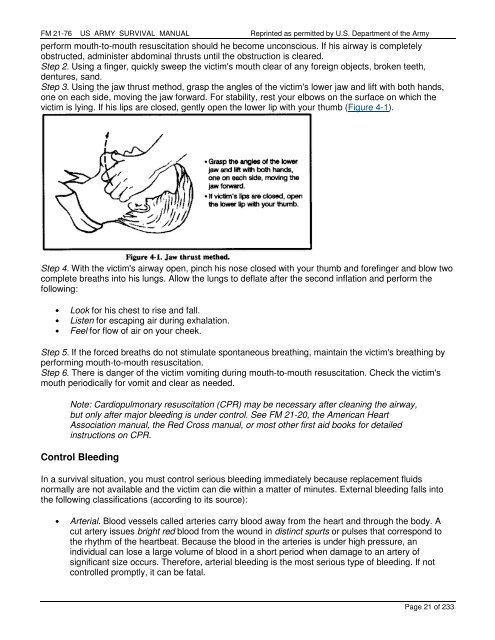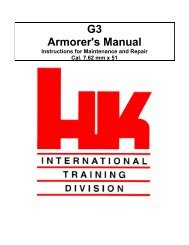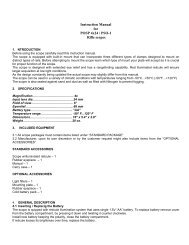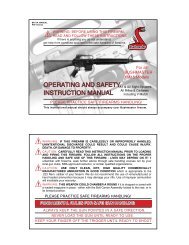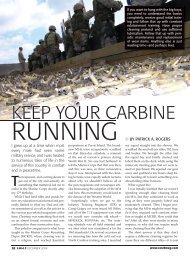FM 21-76 US ARMY SURVIVAL MANUAL - AR15.com
FM 21-76 US ARMY SURVIVAL MANUAL - AR15.com
FM 21-76 US ARMY SURVIVAL MANUAL - AR15.com
You also want an ePaper? Increase the reach of your titles
YUMPU automatically turns print PDFs into web optimized ePapers that Google loves.
<strong>FM</strong> <strong>21</strong>-<strong>76</strong> <strong>US</strong> <strong>ARMY</strong> <strong>SURVIVAL</strong> <strong>MANUAL</strong> Reprinted as permitted by U.S. Department of the Army<br />
perform mouth-to-mouth resuscitation should he become unconscious. If his airway is completely<br />
obstructed, administer abdominal thrusts until the obstruction is cleared.<br />
Step 2. Using a finger, quickly sweep the victim's mouth clear of any foreign objects, broken teeth,<br />
dentures, sand.<br />
Step 3. Using the jaw thrust method, grasp the angles of the victim's lower jaw and lift with both hands,<br />
one on each side, moving the jaw forward. For stability, rest your elbows on the surface on which the<br />
victim is lying. If his lips are closed, gently open the lower lip with your thumb (Figure 4-1).<br />
Step 4. With the victim's airway open, pinch his nose closed with your thumb and forefinger and blow two<br />
complete breaths into his lungs. Allow the lungs to deflate after the second inflation and perform the<br />
following:<br />
• Look for his chest to rise and fall.<br />
• Listen for escaping air during exhalation.<br />
• Feel for flow of air on your cheek.<br />
Step 5. If the forced breaths do not stimulate spontaneous breathing, maintain the victim's breathing by<br />
performing mouth-to-mouth resuscitation.<br />
Step 6. There is danger of the victim vomiting during mouth-to-mouth resuscitation. Check the victim's<br />
mouth periodically for vomit and clear as needed.<br />
Note: Cardiopulmonary resuscitation (CPR) may be necessary after cleaning the airway,<br />
but only after major bleeding is under control. See <strong>FM</strong> <strong>21</strong>-20, the American Heart<br />
Association manual, the Red Cross manual, or most other first aid books for detailed<br />
instructions on CPR.<br />
Control Bleeding<br />
In a survival situation, you must control serious bleeding immediately because replacement fluids<br />
normally are not available and the victim can die within a matter of minutes. External bleeding falls into<br />
the following classifications (according to its source):<br />
• Arterial. Blood vessels called arteries carry blood away from the heart and through the body. A<br />
cut artery issues bright red blood from the wound in distinct spurts or pulses that correspond to<br />
the rhythm of the heartbeat. Because the blood in the arteries is under high pressure, an<br />
individual can lose a large volume of blood in a short period when damage to an artery of<br />
significant size occurs. Therefore, arterial bleeding is the most serious type of bleeding. If not<br />
controlled promptly, it can be fatal.<br />
Page <strong>21</strong> of 233


